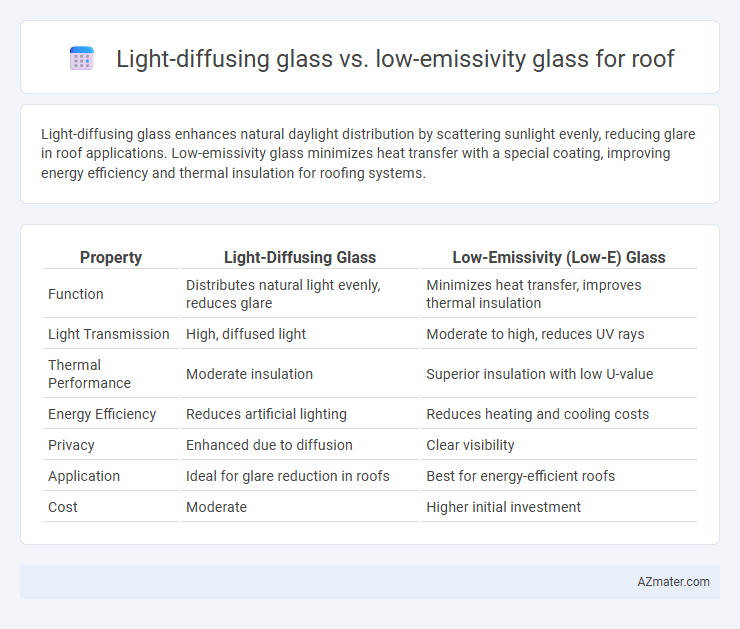Light-diffusing glass enhances natural daylight distribution by scattering sunlight evenly, reducing glare in roof applications. Low-emissivity glass minimizes heat transfer with a special coating, improving energy efficiency and thermal insulation for roofing systems.
Table of Comparison
| Property | Light-Diffusing Glass | Low-Emissivity (Low-E) Glass |
|---|---|---|
| Function | Distributes natural light evenly, reduces glare | Minimizes heat transfer, improves thermal insulation |
| Light Transmission | High, diffused light | Moderate to high, reduces UV rays |
| Thermal Performance | Moderate insulation | Superior insulation with low U-value |
| Energy Efficiency | Reduces artificial lighting | Reduces heating and cooling costs |
| Privacy | Enhanced due to diffusion | Clear visibility |
| Application | Ideal for glare reduction in roofs | Best for energy-efficient roofs |
| Cost | Moderate | Higher initial investment |
Introduction to Roof Glazing Technologies
Light-diffusing glass enhances roof glazing by dispersing natural sunlight evenly, reducing glare and creating a softer interior illumination. Low-emissivity (Low-E) glass improves thermal performance by reflecting infrared heat while allowing visible light to pass through, thus reducing energy loss. Both technologies serve distinct purposes in roof glazing, with light-diffusing glass optimizing natural light quality and Low-E glass maximizing energy efficiency.
What is Light-Diffusing Glass?
Light-diffusing glass is designed to scatter incoming sunlight evenly across a space, reducing glare while maintaining natural brightness, making it ideal for roof installations where uniform daylight distribution is crucial. Unlike low-emissivity (Low-E) glass, which primarily minimizes heat transfer by reflecting infrared energy, light-diffusing glass enhances visual comfort by softening direct solar rays without significantly affecting thermal insulation. This type of glass improves daylight quality and occupant comfort in buildings with large roof areas or skylights, promoting energy-efficient natural lighting.
What is Low-Emissivity (Low-E) Glass?
Low-Emissivity (Low-E) glass features a microscopically thin coating that reflects infrared energy while allowing visible light to pass through, enhancing thermal insulation in roofing applications. This specialized coating reduces heat transfer, thereby improving energy efficiency and maintaining indoor comfort by minimizing heat loss in winter and heat gain in summer. Compared to standard light-diffusing glass, Low-E glass provides superior energy performance without compromising natural light diffusion.
Light-Diffusing Glass: Key Features and Benefits
Light-diffusing glass enhances natural light distribution by scattering sunlight evenly across interior spaces, reducing glare and creating a soft, consistent illumination ideal for roof applications. This type of glass improves visual comfort and energy efficiency by minimizing hotspots and reducing reliance on artificial lighting throughout the day. Compared to low-emissivity glass, which primarily targets thermal insulation by reflecting infrared radiation, light-diffusing glass focuses on optimizing daylight penetration and uniformity without compromising transparency.
Low-Emissivity Glass: Key Features and Benefits
Low-emissivity (Low-E) glass for roofs offers superior thermal insulation by reflecting infrared heat while allowing visible light to pass through, significantly reducing energy costs for heating and cooling. This advanced coating minimizes solar heat gain, enhances indoor comfort, and protects furnishings from UV damage by blocking harmful ultraviolet rays. Compared to light-diffusing glass, Low-E glass provides a more efficient energy-saving solution with clearer transparency and better climate control.
Thermal Performance Comparison
Light-diffusing glass enhances natural daylight distribution while slightly reducing solar heat gain, promoting balanced interior temperatures with moderate thermal insulation. Low-emissivity (Low-E) glass features a microscopically thin coating that minimizes infrared and ultraviolet light transmission, significantly improving thermal insulation by reflecting radiant heat and reducing energy loss. For roofing applications, Low-E glass provides superior thermal performance by maintaining indoor temperature stability and lowering heating and cooling costs compared to light-diffusing glass.
Natural Light Optimization: Which Glass is Superior?
Light-diffusing glass excels at dispersing natural light evenly across interior spaces, reducing glare and creating a soft illumination ideal for roof applications where balanced daylight is crucial. Low-emissivity (Low-E) glass primarily focuses on thermal performance by minimizing heat transfer while allowing visible light to pass through, but it does not scatter light as effectively as light-diffusing glass. For superior natural light optimization on roofs, light-diffusing glass is the preferred choice due to its enhanced diffusion properties that maximize usable daylight without compromising visual comfort.
Energy Efficiency Analysis
Light-diffusing glass enhances natural daylight penetration while reducing glare, contributing to lower reliance on artificial lighting and improved indoor comfort in roof applications. Low-emissivity glass significantly reduces thermal heat transfer by reflecting infrared radiation, thus minimizing heat gain in summer and heat loss in winter, leading to substantial energy savings in heating and cooling. Comparing both, low-emissivity glass offers superior insulation properties for energy efficiency, whereas light-diffusing glass optimizes daylight utilization, often making a combined approach beneficial for holistic energy management.
Installation and Maintenance Considerations
Light-diffusing glass for roofs requires precise installation to ensure even light distribution and prevent hot spots, with maintenance focused on keeping the surface clean to maintain diffusion efficiency. Low-emissivity (Low-E) glass demands careful handling during installation to preserve its thin metallic coating, and regular inspections to detect any seal failures that could reduce thermal performance. Both types necessitate specialized contractors experienced in glazing systems to optimize durability and energy efficiency throughout service life.
Choosing the Right Roof Glass: Key Takeaways
Light-diffusing glass for roofs enhances natural light distribution and reduces glare, creating a more comfortable indoor environment, while low-emissivity (Low-E) glass primarily improves energy efficiency by minimizing heat transfer and reflecting infrared radiation. Selecting the right roof glass depends on balancing daylight quality with thermal insulation needs, where light-diffusing glass suits spaces prioritizing uniform illumination and Low-E glass benefits those aiming for energy savings and temperature control. Assessing factors such as solar heat gain coefficient (SHGC), visible light transmission (VLT), and regional climate conditions ensures optimal performance and comfort for roofing applications.

Infographic: Light-diffusing glass vs Low-emissivity glass for Roof
 azmater.com
azmater.com